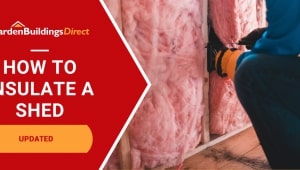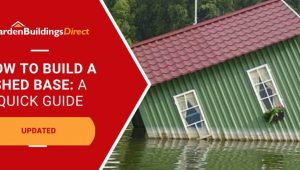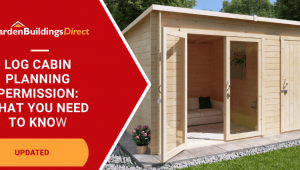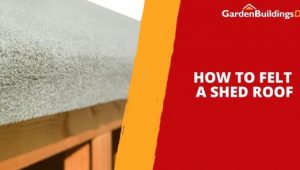Jump to:
Garden sheds have long been a staple in many UK homes and gardens. These structures take pride in solving outdoor storage dilemmas and are a significant ‘home improvement’ that homeowners are eager to invest in, and you may be, too — that’s why you’re here.
But with financial considerations in mind, you’ll want to make sure every pound goes on the right shed. We understand how important it is and that’s why, together with our experts, we’ve curated this shed buying guide, addressing all the key points and FAQ. Follow the guide and consider what you need from each element of a shed.
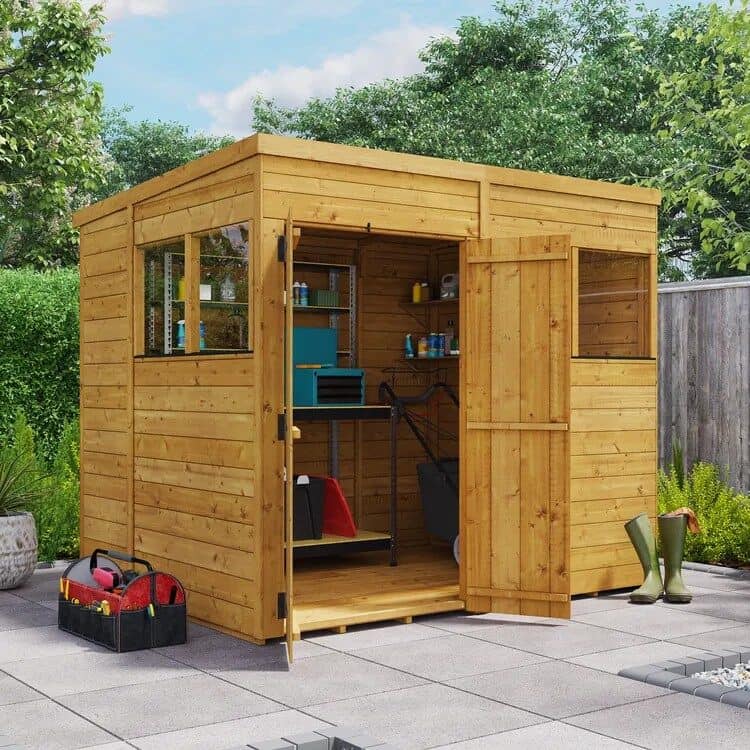


Uses for a Garden Shed
A garden storage shed lives up to its name. It provides a place for stowing items that may otherwise take up valuable space indoors. This can include garden tools, outdoor equipment, and other household items.
But there’s so much more potential to a shed than simply a dumping ground for clutter. With the huge variety in sizes and shapes, there isn’t one cookie-clutter version of a shed. Beyond storage, common shed purposes include:
- Workshop shed: For DIY projects, woodworking, and other crafts.
- Gym shed: Equipped with garden gym equipment and other fitness essentials.
- Potting shed: As a sheltered space for gardening tasks and cultivating plants.
- Bike shed: For securing bikes, protecting them from the elements, and organising.
That’s not all of them of course – you can tailor the purpose of your shed to your needs and interests, but it’s crucial you have a grasp on what it will be used for. This is because the use determines the type of shed you’ll need. For instance, if you’re looking to create an art studio, you’ll need a shed with windows and enough space to fit your equipment in.
Electricity in your shed is a common need for a lot of popular uses. Whether you just want some ceiling lights, the ability to run power tools, or to power an office shed setup, you’ll want a power supply. Check out our guide to installing shed electricity for help with this.
Shed planning permission
This varies by property and by your personal usage, and it’s one of the most important things to know before you start.
Most people in the UK will not require any planning permission whatsoever to add a shed to their property, in the back garden (classed as a permitted development). But some will.
Planning permission is required for a shed in the front garden — more about that via the link.
So, let’s say you’re not putting your shed in the front garden, it’s not going to take up more than half your outdoor space, and you’re buying one of our sheds which always come under the maximum height limit. In that case, you should be fine, but some land is subject to extra rules.
That’s why checking your local planning permission rules is one of the first things you should do when shopping for a shed.
Check out the full list of rules in our guide to shed planning permission.
Garden Shed Types
Looking for storage to stow away your bike? Or a large unit to pursue your creative endeavours?
Somewhere out there is a shed for you! Here are the common shed type ideas to get you thinking.
Corner sheds
If you have an oddly shaped garden, shopping for garden sheds can be tricky. This is where corner sheds come into the picture.
A corner shed makes full use of those awkward spots in yards. A shed like this is ideal for when you’re desperate for outdoor storage but can’t find the right spot for a large unit.
They come in all shapes and sizes, but this one pictured above is even big enough to be used as a guest room.
Workshop sheds
Workshop sheds are perfect for those who want a space to work on hobbies, home projects, or even professional tasks.
Some models have more rooms to provide for a crafting bench and more. This is perfect if you want to paint models, build and repair furniture, or maintain your vehicles.
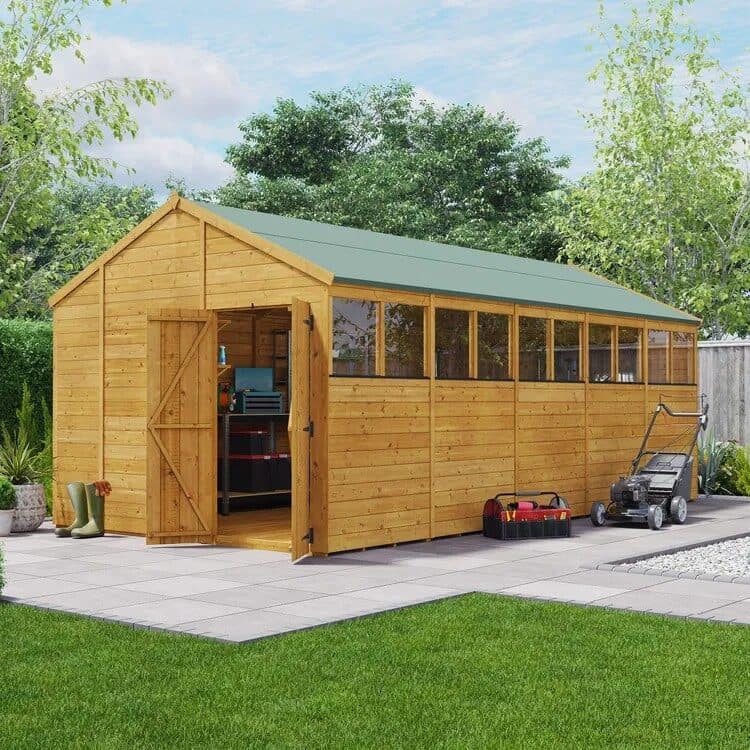
Modern workshop sheds combine practical storage with contemporary looks — discover what makes a modern shed and how newer designs blend style with function.
Small sheds
The benefits of mini sheds can be pretty big. For more inspiration, check out our best sheds for small gardens.
They’re ideal if you want to invest in garden storage without eliminating too much green space. Plus, they are just the right size for storing bikes or new wheelie bins.
There are 2 ways to look at small sheds: small floor space, and low height. Many people look for the latter, especially if they’re after discrete storage that doesn’t poke high over the top of a low fence.
Consider the shed pictured below, for example. It could be a prime choice to include on a front garden (planning permission required). Or perhaps you’re just on a budget and don’t have many large items that need storing.
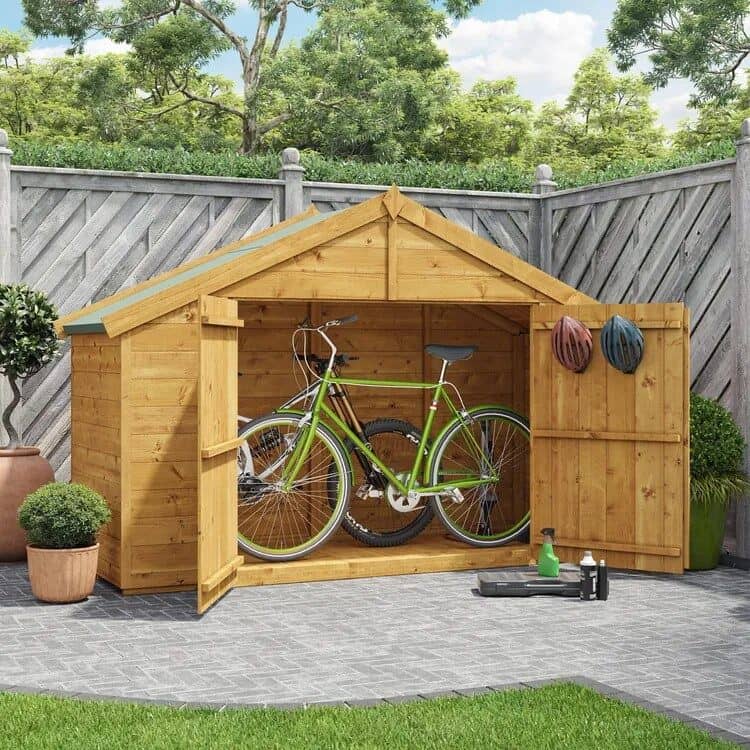
The only other consideration for a shed of this nature is that you can’t actually stand inside it. For walk-in sheds, you’ll need them to be above head height, but you can still opt for ones that have an area as small as 4×4 feet.
If cost is your main concern, see our budget garden sheds under £300.
Tall store sheds
If you want a shed mainly for storing your garden tools, a tall store might be for you. It provides all the benefits of a shed without committing to full-size units.
Look for a unit with corner shelves to hold smaller tools and equipment, giving you more space on the floor.
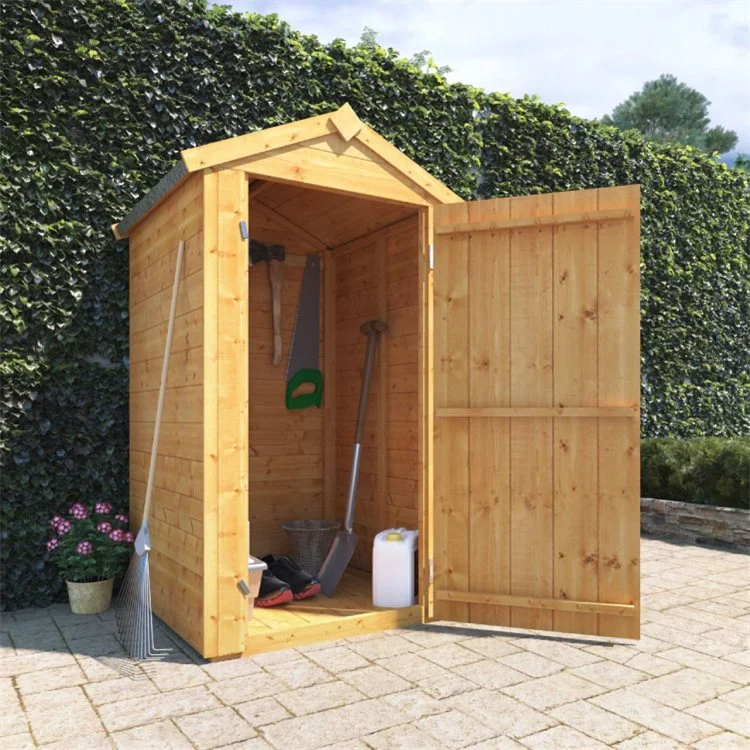
Vehicles stores
If a mini shed that can house bicycles isn’t enough for your needs, you need something a little larger. Modern garden storage is set up to hold more than just a few deck chairs and DIY tools.
Check out this wooden garage shed as an option. It’s big enough to fit a car through its double doors.
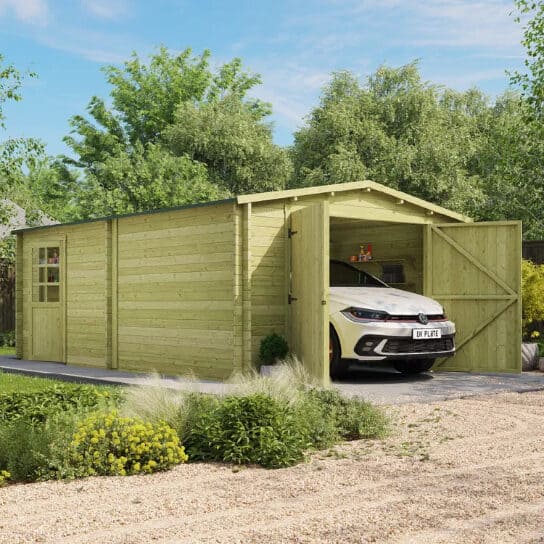
We’ve got another guide to help decide whether you should buy a shed or a garage.
Sheds by Material
There are 3 main materials of shed on the market: wood, plastic, and metal. While some opt for a brick shed, this is much more permanent and expensive, with less flexibility to change it once it’s built. Here’s what you need to know about each material.
Wooden sheds
These are the most common and the type of shed we manufacture ourselves at our factory in Worksop, Nottinghamshire.
Wooden sheds carry a range of benefits:
- You can paint them any colour you wish.
- They are easy to customise with extra bolt-ons like lights and hooks.
- Timber has naturally insulating properties for a more comfortable internal temperature (by comparison — they’re not that insulated on their own). But this guide can help: How to Keep Your Garden Shed Cool in Summer
- They’re more adaptable for the different types of uses listed above.
- They’re generally more aesthetically pleasing for most gardeners, depending on personal taste.
However, wooden sheds do require more maintenance than their plastic and metal counterparts. Exposure to outdoor moisture means the timber requires treatment to protect it from rot, decay and insect infestation.
Timber also naturally shifts over time, especially after it is first built. You need to bear this in mind before you start with any customisations that might lock parts together that need to be able to move. Boards have been known to crack due to errors because of this.
They do take a little more work to install than metal or plastic sheds, as our low cost wooden sheds are sold as self-assembly shed kits. We don’t offer an installation service, although you are welcome to hire a joiner to take care of it if you wish (do this after it’s delivered). It doesn’t take skills beyond some basic DIY, with tools such as a hammer and spirit level. It is a two-person job, though. Our prefab shed kits generally have pre-assembled wall panels, so you’re not having to put every single wooden board into place.
Curious how long the build will take? Our blog on how long it takes to build a shed breaks down build times for each style, including if you went completely DIY.
Metal sheds
With very little maintenance required, metal sheds are a reliable, secure solution for storage, and large models can also be used as a workshop space.
They do tend to get hotter than wooden sheds during the summer due to the high heat transfer of metal, so they are generally used purely as storage and not as a space to inhabit for long periods of time.
Another common question people have is: are metal sheds noisy when it rains? Click this link to find out.
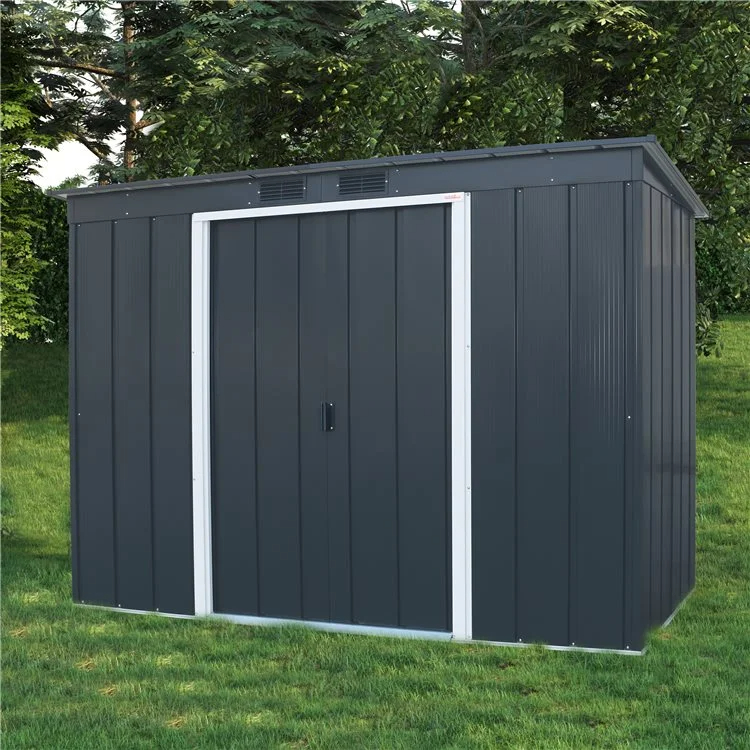
Learn more benefits of metal sheds.
Plastic sheds
Plastic sheds can withstand elements but are still lightweight enough to be used as temporary storage.
This saves you time and money if you’re looking for a quick fix for your outdoor storage problems.
Compare metal and plastic sheds in our guide: What Lasts Longer: Metal or Plastic Sheds?
Choosing Shed Size
Shed dimensions vary depending on the style and material – manufacturers also play a role. Each size determines the structure’s functionality and how well it fits your demands.
Sheds can come in various dimensions to suit your needs and available space. Sizes commonly available are as follows:
| 6×3 | 6×4 | 6×6 | 6×8 | 8×8 |
| 10×6 | 10×8 | 12×8 | 12×10 | 20×10 |
A size that’s too small may result in insufficient storage or a cramped workspace. Sheds can come in sizes as large as 20×16, though some gardeners may find this overwhelming and over-the-top.
A well-chosen unit size ensures efficient utilisation and organisation, meaning it can accommodate whatever you plan to store inside with ease and comfort. Furthermore, it can impact local regulations, which may restrict shed size. This applies to any shed buying guide and material, such as wooden, plastic or metal sheds.
Shed Location
Where you situate your shed will influence its utility and impact on your property. We emphasise its importance for convenient access to tools and equipment. Shed placement also impacts environmental factors like sun exposure and drainage. This is crucial for long-term durability and may help for future landscaping ideas.
Consider what you’ll be placing your shed next to or near. If it’s by or beneath a tree, it could be at risk of falling twigs or branches during high winds. The shadow of the tree could also affect how much sunlight it receives.
It’s beneficial to plan the location of your shed before you buy it. This ensures you don’t run into any “surprises” when it comes to installation.
Note: You can always relocate or do “shed moving” in the future for a makeover or to accommodate a new garden layout.
Shed Cladding Types and Thickness
In wooden sheds, cladding refers to the outer covering of the outbuilding’s timber panels, which sits against the shed’s framing. It makes up the outer structure — in essence, the walls, floor, and roof. Measurements relating to these features apply to the thickness.
There are several factors to consider when it comes to selecting the right cladding type:
Overlap cladding:
A cost-effective option with boards that overlap each other. It provides decent weather resistance, but it may have less insulation.
Shiplap cladding:
Like overlap, but with a flatter finish. There are some tongue and groove connections between the boards.
Standard tongue and groove:
Completely flat boards joined at the edges with tongues that insert into grooves. This is thicker overall than shiplap, leaving you with a flat wall surface that provides the best protection against rainwater and wind.
Get a more detailed comparison in our guide to the best shed cladding.
Consider your budget, the intended use of the shed, and your local climate. Shiplap and standard T&G cladding are ideal for areas with harsh weather conditions. In contrast, overlap types may suffice in milder climates.
Read more:
How Thick Should Shed Cladding Be?
Shed Cladding Options: Should You Go Vertical or Horizontal?
Shed Roof Types and Coverings
You’ll likely encounter various choices for shed roofing and coverings. For roofing, available options are:
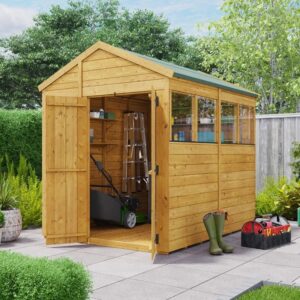
Apex Roof
The apex roof, also known as a gable roof, is a traditional V-shaped design with two sloping sides meeting at a ridge. It offers a classic appearance and efficient rainwater drainage.
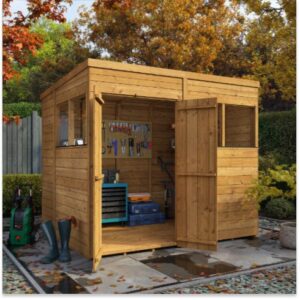
Pent Roof
A pent roof features a single slope, ideal for sheds against a wall or fence. It’s a sleek, modern choice that maximises interior space.

Reverse Apex Roof
For all intents and purposes, a reverse apex shed is structurally identical to an apex shed, except the doors are underneath the slope of the roof rather than under the gable end. Some modular sheds make it possible to achieve both orientations on the same model.
Along with the roof itself, you’ll also need to consider roof coverings:
- Felt roof Covering: A common and cost-effective roofing material. It’s easy to install and provides excellent weather protection. Keep in mind, though, that it may have a shorter lifespan than other materials.
- EPDM: Stands for Ethylene Propylene Diene Monomer. It’s a rubber roofing that promises a durable and long-lasting option. It guarantees superior weather protection and insulation.
- Shingles: Roof Shingles are typically made of asphalt, wood, or fibreglass. Regardless, they provide an attractive and long-lasting roofing solution.
Top tip: Consider the shed’s design, your budget, and local weather conditions. Each option has advantages, so you can select the one that best suits your needs.
Windows and Doors
These aspects of a shed contribute to the overall functionality, security, and aesthetics. Adequate windows provide natural light and ventilation, enhancing overall ambience. They are especially vital for workspace sheds like a makeshift garden office.
For this, you have two options: 1.) with windows — opting for glazing, and 2.) windowless. Glazing can be real glass or a safer alternative like styrene, which is shatterproof. It is vital for tasks inside a shed but not needed for basic storage. The latter option is a smart choice for security enhancement, which is essential for models used for bike storage.
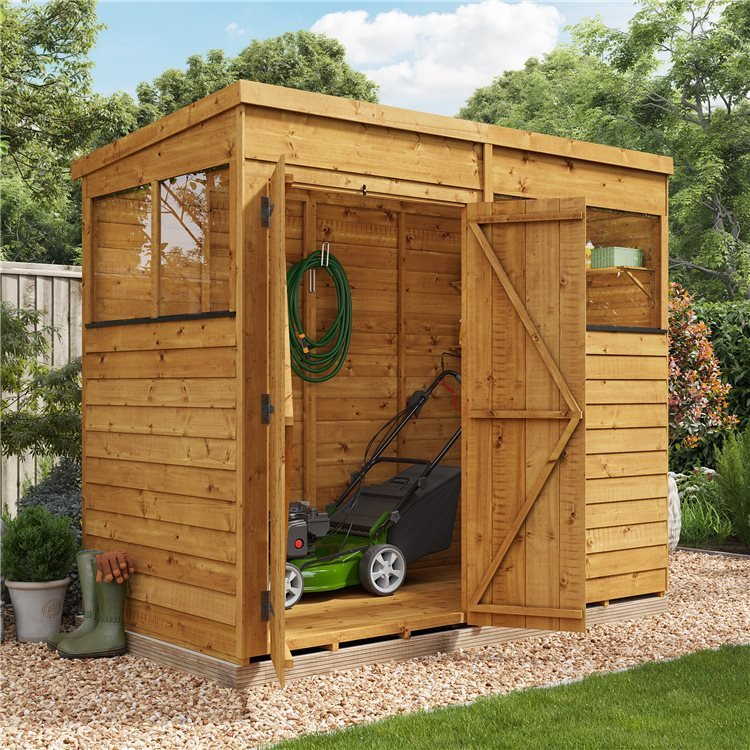
The right window style and placement ensure the interior remains well-lit and pleasant. Top tip: Consider windows that open if you’re after ventilation.
As for the entry points or doors, go for robust, lockable ones for top security. The size should accommodate the intended use. Most shed models come with single or double-door options. One maximises wall storage, but for storing large items like ride-on mowers — make it two! Sliding doors work well in tight spaces, too.
If you’d rather avoid buying a whole new shed for the sake of windows, read this: How to add Windows to a Shed.
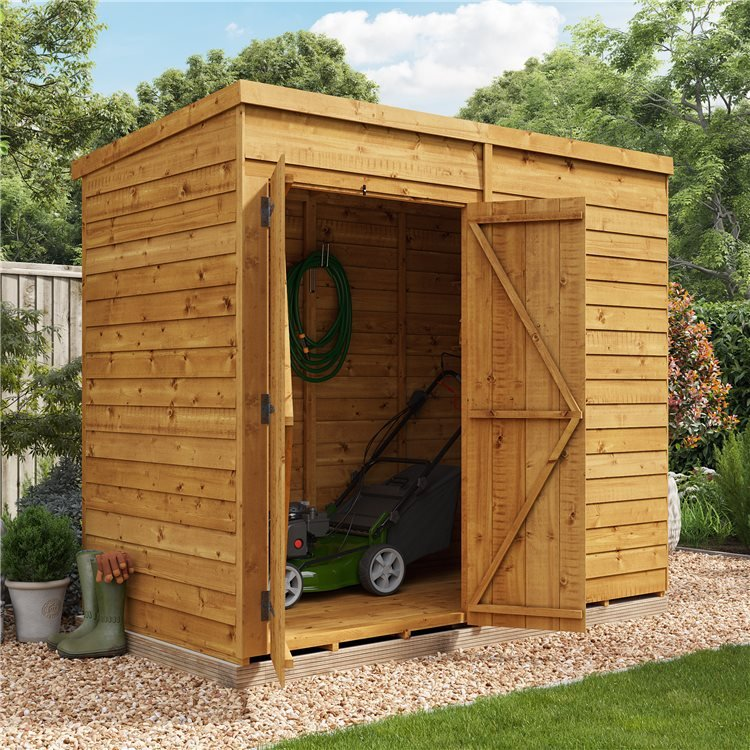
Shed Bases
All sheds need a base. That means a surface for it to stand upon, which won’t shift, sink, or allow the shed to dip at all. You might also want to consider anchoring, particularly for metal and plastic sheds.
A base needs to be:
- Flat and level
- Solid (not grass)
- Not somewhere water can pool
Here’s a common question when it comes to bases: can you use gravel? We’ve got a guide for that: Building a Shed on Gravel.
A solid foundation is key to top performance and longevity, as with any garden building. This rule isn’t an exception but a must in a shed buying guide. There are four types available on the market and/or for a DIY approach to building a shed base:
1. Concrete shed base
This shed base type offers exceptional stability and durability and is best for heavy sheds. It provides excellent protection against ground moisture and can last for decades.
2. Wooden shed base
Pressure treated wood base kits are a versatile and cost-effective choice. It’s suitable for sheds of various sizes and can be customised to the structure’s dimensions. Properly treated wooden bases can last for many years. We manufacture our own wooden base and offer it as an added option on most of our wooden buildings.
3. Plastic shed base
Lightweight, easy to install, and rot-resistant — the top qualities of plastic bases. They work well for smaller units and are effective at preventing ground moisture. You can often fill them with gravel to create a solid, flat block.
4. Paving slabs
A flat, sturdy, and often rectangular piece of concrete, stone, or other materials. Placed on a level surface, these slabs create a stable platform for the shed, offering support. Among the popular choices due to their durability and ease of installation.
All of these options require some preliminary underlaying of compacted hardcore to prevent sinking.
When it comes to wooden sheds, it’s especially important that the bottom of the shed not be directly touching the ground. For this reason, our wooden sheds always come with raised pressure-treated floor bearers.
Another common question: Can I Build a Shed on Decking?
If you’re working with uneven ground or want a simpler option, see our guide on how to level ground for a shed without digging for step-by-step tips.
Shed Accessories
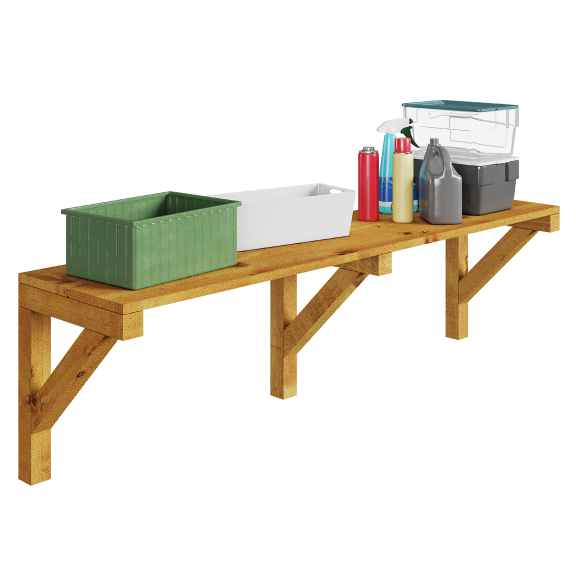
Shed accessories are essential to getting the most out of your investment. These extras can transform a basic garden storage into an extraordinary one. What’s more, they make the structure more versatile, allowing you to tailor it to your needs.
Shelving, hooks, and tool racks are great examples which help improve organisation. Consider lighting and insulation if you wish to extend your shed’s utility year-round. Shed locks and alarms can help enhance security, safeguarding your belongings.
Frequently Asked Shed Questions
Do Sheds Require Planning Permission?
You don't need planning permission for a shed if:
- You are placing your shed in the back garden or at the side of your house (not forward of the principal elevation)
- Your land is not subject to special rules (check with your local authority)
- Your shed is within 2 metres of a boundary but less than 2.5 metres total height (all of our sheds are under 2.5m)
- Your shed is further than 2 metres from a boundary and:
- with a dual pitched (apex) roof less than 4 metres tall and under 2.5 metres at the eaves
- with any other type of roof less than 3 metres tall and under 2.5 metres at the eaves
- Your shed leaves more than half of the original outdoor space free of buildings (accounting for other building works)
As long as you stay within the rules, your shed will be classed as a permitted development.
You will need planning permission for a shed if:
- Your shed will be placed forward of the principal elevation line (front of the house)
- You are on a listed property, areas of outstanding natural beauty, or other areas subject to special rules
- You are placing the shed less than 2 metres from the property boundary with part of the shed taller than 2.5 metres (does not apply to our sheds unless you raise them on a tall base or deck)
- Any part of the shed exceeds 4 metres height on a dual-pitched roof or 3 metres on any other roof type
- The eaves height (lowest part of the roof) exceeds 2.5 metres height
- The shed would cause the outdoor space surrounding the original house to be more than 50% built over
These are the rules for England. The rules in Scotland and Wales provide different measurements and definitions of outdoor space for the 50% rule.
For deeper detail, read our guide to planning permission for sheds.
What to consider when buying a shed
Before you purchase a garden shed, think about weighing up the below:
- Price vs. Quality - This can be a tricky balancing act, but just remember that a garden shed is an investment for the future. We suggest going for a shed built with better materials (like high-quality European sourced timber) at a slightly higher price, so you can be safe in the knowledge of getting an excellent garden shed.
- Material - Wooden, metal and plastic sheds each have their own unique advantages. Think about what you plan to use your shed for, as well as your own personal stylistic preferences.
- Location - Aside from the size of your garden, you should also think about how you intend to use your shed. You don’t want to place it in an inaccessible area, or one which receives little natural sunlight.
Why buy a wooden garden shed?
Undoubtedly the most popular type of garden shed, wooden sheds have been a staple of gardens for years, thanks to their multi-purpose use and classic look. Listed below are some the most important wooden shed advantages:
- Traditional aesthetic.
- Wooden sheds are multi-purpose. Easily used as either a DIY workshop or a storage area.
- Highly customisable. Wooden sheds can be painted and modified to suit your personal preferences.
Why buy a metal garden shed?
Metal garden sheds have seen a serious rise in popularity over recent years, thanks to their sturdy nature. Here are some of the best reasons to buy a metal shed:
- A budget-friendly, affordable option.
- Easy to assemble.
- Durable. Perfect for heavy-duty DIY.
- Virtually maintenance-free.
Why buy a plastic garden shed?
Plastic sheds are the ideal choice for those seeking a low maintenance, yet highly practical garden shed. Here are a few of the biggest advantages of plastic sheds:
- Highly portable and easy to build. You’ll have little difficulty in moving a plastic shed from one area of your garden to another.
- Long lasting and durable, thanks to the impermeable nature of plastic.
- Multi-functional.
What is the strongest type of shed?
The strength of a shed largely depends on the materials used in its construction. Steel sheds are typically the strongest. They offer robust protection against the elements and potential intruders. What’s more, the material is durable, weather-resistant, and virtually maintenance-free.
For ultimate strength, look for sheds with galvanised steel frames and walls. Metal outperforms wood and plastic in terms of overall strength and security. However, the choice also depends on your specific needs, budget, and the intended use of the shed.
What type of shed is the cheapest?
The answer often leads to wooden sheds, particularly those made with lower-cost softwood. Although they can be cheap, their longevity may not match that of pricier materials such as steel. Keep in mind that maintenance costs should also be considered.
How many years do sheds last?
The lifespan of a shed varies widely based on materials and maintenance. A well-maintained metal shed can last 20-30 years or more. Meanwhile, wooden ones typically endure 10-15 years and more for pressure treated sheds. Plastic storage sheds tend to last 10-20 years.
Regular maintenance, like treating wood and replacing roofing, can extend their lifespan.
What type of sheds last the longest?
Metal garden sheds are renowned for their durability and resistance to weather. Thus making them the longest-lasting option in a typical shed buying guide. Galvanised steel frames and walls offer exceptional protection against rust and decay.
Is shed insulation necessary?
Whether or not to insulate your shed depends on its use. If temperature control is vital, insulation is beneficial. It’s also an investment that pays off in comfort and energy savings when the shed serves as a living space. For help on installation, consult our help insulation guide.
Insulation helps maintain a comfortable environment and reduces energy costs. Note: For basic storage sheds, insulation may not be necessary.
Should my shed have a floor?
We recommend including a floor in your shed for several reasons. It creates a clean, level surface, preventing ground moisture. A floor also helps deter pests from entering and offers insulation.
If your shed doesn’t come with a floor, consider adding one to enhance usability and longevity.
You might want to go without a floor if your shed is for vehicle storage or if you have a metal or plastic unit where you expect it to get wet inside.
How do I prepare for my shed?
Preparation is key for a successful shed installation. Start by clearing and levelling the area where the shed will be placed. Ensure proper drainage to prevent water accumulation. Gather all the necessary tools and materials. Consider any utility connections if your shed requires them.
Note: Some regions may require permits or adherence to zoning regulations. Make sure to check with your local authorities!
How big does your shed need to be?
Consider what you plan to store or use the shed for. Measure your larger items and allow extra room for movement. It’s better to choose a bit larger shed than you initially think you need. This trick provides flexibility and ensures you won’t outgrow your shed too quickly.
We have a separate guide to help you choose a shed size with more detailed advice.
Can you Live in a Shed?
Probably not. But this is a more complicated question, so we've got a separate guide for it: Living in a Shed Rules UK
More from our shed experts:
• Is Your Shed Spying on You? The Rise of Smart Garden Sheds
• How to Dispose of a Shed
